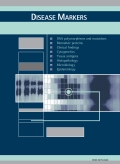Authors: Li, Yu-Fen | Sung, Fung-Chang | Tsai, Ming-Hsui | Hua, Chun-Hung | Liu, Chiu-Shong | Huang, Yao-Te | Yeh, Chih-Ching
Article Type:
Research Article
Abstract:
BACKGROUND: This case-control study investigates the role of xenobiotic-metabolizing genes, including glutathione S-transferases (GSTs) and cytochrome P450 1A1 (CYP1A1) and 2E1 (CYP2E1), in the susceptibility to oral potentially malignant disorders (OPMDs). METHODS: The genotypes of GSTM1, GSTT1, GSTP1, CYP1A1*2C, and CYP2E1 PstI/RsaI polymorphisms were determined for 217 OPMD cases and 492 age- and sex-matched controls from a Taiwanese penitentiary. RESULTS: Compared to the GSTM1-present genotype, the GSTM1-null genotype was significantly associated with increased risk
…of leukoplakia (odds ratio [OR]=1.46, 95% confidence interval [CI]=1.01–2.10). Similarly, compared to the CYP1A1*2C A/G+G/G genotype, the CYP1A1*2C A/A genotype was significantly associated with increased risk of leukoplakia (OR=1.64, 95% CI=1.12–2.40), particularly for smokers consuming > 13 pack-years of cigarettes (OR=2.40, 95% CI=1.40–4.11) (Interaction P=0.039). In addition, participants with 4–5 risk genotypes (OR > 1) experienced higher risks for leukoplakia than those with 0-1 risk genotypes (OR=3.19, 95% CI=1.65–6.15) (Trend test P=0.001). CONCLUSIONS: Our findings suggest that the CYP1A1*2C A/A genotype may increase the risk of leukoplakia, especially for heavy smokers. Xenobiotic-metabolizing genes may simultaneously modulate this disease risk. These observations require further confirmation with larger samples.
Show more
Keywords: Glutathione S-transferases, cytochrome P450 1A1, cytochrome P450 2E1, polymorphisms, oral potentially malignant disorders, cigarette smoking
DOI: 10.3233/DMA-130967
Citation: Disease Markers,
vol. 34, no. 4, pp. 247-255, 2013
Price: EUR 27.50





